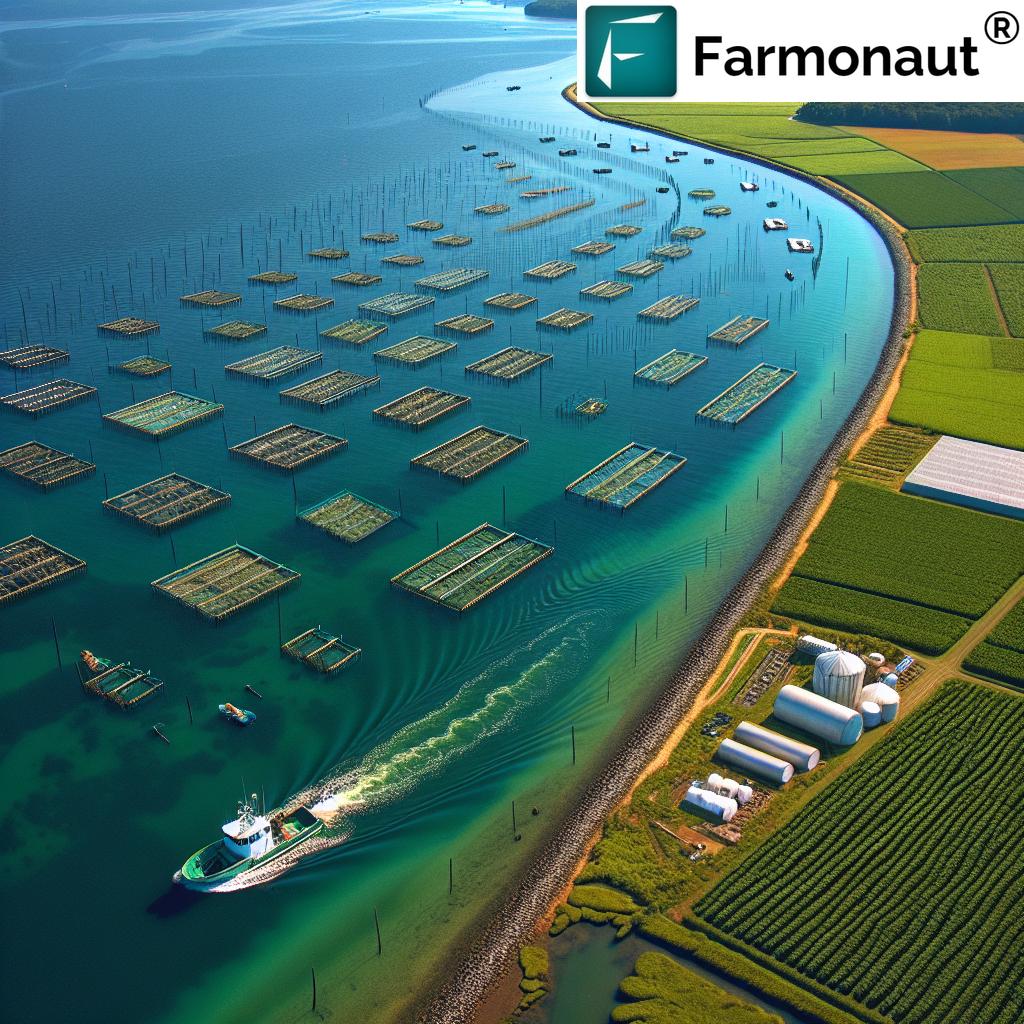Maryland’s Chesapeake Bay Legacy Act: Revolutionizing Sustainable Agriculture and Aquaculture for a Thriving Economy
“The Chesapeake Bay Legacy Act aims to revolutionize Maryland’s approach to water quality, sustainable agriculture, and aquaculture in just one comprehensive bill.”
In a landmark move that promises to transform the landscape of Maryland’s agriculture and aquaculture industries, Governor Wes Moore has announced the Chesapeake Bay Legacy Act. This groundbreaking legislation, set to be a cornerstone of the Moore-Miller Administration’s priorities for the 2025 General Assembly, represents a holistic approach to addressing the environmental and economic challenges facing the Chesapeake Bay region.
As we delve into the intricacies of this act, we’ll explore how it aims to balance economic growth with environmental conservation, creating a sustainable future for Maryland’s Bay region. From regenerative agriculture practices to streamlined oyster aquaculture, the Chesapeake Bay Legacy Act is poised to usher in a new era of prosperity and ecological health.
The Significance of the Chesapeake Bay
The Chesapeake Bay is not just a body of water; it’s the lifeblood of Maryland’s economy and a natural treasure that demands our protection. Governor Moore aptly described it as “one of our state’s most powerful vehicles for economic growth and a treasured heirloom that must be protected.” This statement encapsulates the dual focus of the Legacy Act: economic vitality and environmental stewardship.
Consider these striking facts:
- The tourism economy around the Chesapeake Bay generates a staggering $3.2 billion in economic activity annually.
- Maryland’s seafood industry, intrinsically linked to the Bay’s health, contributes about $600 million to the state’s economy each year.
- Improved water clarity could significantly increase property values in the state, according to Environmental Protection Agency estimates.
These figures underscore the immense economic potential that lies in preserving and enhancing the Chesapeake Bay’s ecosystem. The Legacy Act recognizes this potential and seeks to unlock it through a series of innovative measures.
Revolutionizing Agriculture: The Regenerative Approach
At the heart of the Chesapeake Bay Legacy Act is a commitment to transforming agricultural practices in Maryland. The act introduces several key reforms aimed at promoting regenerative agriculture, a set of farming practices that improve soil health, increase biodiversity, and mitigate climate change impacts.
Long-Term Leases for Sustainable Farming
One of the most innovative aspects of the act is the provision for longer-term public land leases. The Maryland Department of Natural Resources will be empowered to offer extended leases on state agricultural land to farmers who commit to building healthy soil through regenerative practices. This approach serves multiple purposes:
- It provides farmers with the security and incentive to invest in long-term soil health improvements.
- It promotes sustainable land management practices that benefit both the environment and agricultural productivity.
- It addresses the challenge of land access for new and beginning farmers, particularly those interested in sustainable agriculture.
This reform is particularly significant in light of the U.S. Department of Agriculture’s 2022 Census of Agriculture, which revealed that only 9% of farmers were under the age of 35. By lowering the barrier to entry for new farmers, Maryland is positioning itself at the forefront of agricultural innovation and sustainability.
Leaders in Environmentally Engaged Farming Program
Another key initiative introduced by the Legacy Act is the Leaders in Environmentally Engaged Farming Program. This program, to be administered by the Maryland Department of Agriculture, aims to recognize and incentivize farmers who promote best management practices and community engagement in watershed restoration efforts.
The program will focus on:
- Promoting conservation practices such as riparian buffers and cover crops
- Building partnerships between industry and innovative incentives to address environmental goals
- Supporting both lifelong farmers and beginning growers in adopting sustainable practices
By creating a framework for recognition and support, this program encourages the widespread adoption of environmentally responsible farming techniques across Maryland.

Enhancing Water Quality Monitoring
A critical component of the Chesapeake Bay Legacy Act is the expansion of water quality monitoring throughout the state. This enhanced monitoring serves several crucial purposes:
- It provides more accurate and comprehensive data to evaluate Chesapeake Bay restoration efforts.
- It allows for more targeted and cost-effective pollution reduction practices.
- It empowers Marylanders with better understanding of water quality in their local communities.
By leveraging this expanded monitoring data, the state can make more informed decisions about where to implement pollution reduction projects for maximum benefit and minimum cost. This data-driven approach aligns with modern environmental management practices and ensures that resources are used efficiently in the pursuit of cleaner waterways.
Revolutionizing Aquaculture: Streamlining Oyster Farming
The Chesapeake Bay Legacy Act recognizes the significant role that aquaculture, particularly oyster farming, plays in both the economy and ecology of Maryland. To support this growing industry, the act introduces several key reforms:
Streamlined Aquaculture Lease Review Process
The act aims to streamline the review process for aquaculture leases, promoting efficiency in the industry. This reform will:
- Reduce bureaucratic hurdles for oyster farmers
- Allow leaseholders to continue operations while waiting for permit renewals
- Encourage growth and investment in the aquaculture sector
These changes are designed to support an industry that already has an estimated economic impact of more than $13 million annually in Maryland. With record aquaculture harvests of over 90,000 bushels in each of the past three years, the potential for growth is substantial.
Water Quality Trading Credits for Oyster Restoration
In an innovative move, the Legacy Act empowers the Maryland Department of the Environment to authorize oyster restoration projects as eligible for water quality trading credits. This provision recognizes the vital ecological role that oysters play in improving water quality and provides an additional incentive for oyster restoration work.
The benefits of this approach are multifaceted:
- It encourages private investment in oyster restoration
- It leverages the natural filtering capacity of oysters to improve water quality
- It creates a sustainable model where ecological restoration and economic incentives align
“Maryland’s oyster aquaculture industry, supported by the Legacy Act, contributes significantly to the state’s economy while providing ecological benefits.”
Economic Impact and Job Creation
The Chesapeake Bay Legacy Act is not just an environmental initiative; it’s a comprehensive economic strategy. By fostering sustainable practices in agriculture and aquaculture, the act aims to create jobs, boost tourism, and drive economic growth across Maryland.
Job Creation in Sustainable Industries
The act’s focus on regenerative agriculture and expanded aquaculture is expected to create numerous job opportunities across various sectors:
- Sustainable farming practices require skilled labor and create opportunities for agricultural consultants and technology experts.
- The expansion of oyster aquaculture will lead to more jobs in harvesting, processing, and distribution.
- Enhanced water quality monitoring will require additional environmental scientists and technicians.
Boosting Tourism and Property Values
Cleaner waterways and a healthier Chesapeake Bay ecosystem are expected to have a significant impact on Maryland’s tourism industry and property values:
- Improved water quality can lead to increased recreational activities, attracting more tourists to the region.
- Enhanced natural beauty and ecological health can drive up property values in waterfront and Bay-adjacent areas.
- A thriving oyster industry can become a tourist attraction in itself, promoting culinary tourism.
Technological Innovation in Agriculture
While the Chesapeake Bay Legacy Act focuses on policy and regulatory changes, it’s important to recognize the role that technology plays in modern sustainable agriculture. Companies like Farmonaut are at the forefront of this technological revolution, offering innovative solutions that complement the goals of the Legacy Act.
Farmonaut provides satellite-based farm management solutions that can significantly enhance the effectiveness of regenerative agriculture practices promoted by the act. Their platform offers:
- Real-time crop health monitoring using satellite imagery
- AI-based advisory systems for optimized farm management
- Blockchain-based traceability for agricultural products
These technologies can help Maryland farmers implement and maximize the benefits of sustainable farming practices, aligning perfectly with the goals of the Chesapeake Bay Legacy Act.
Environmental Benefits and Sustainability
The Chesapeake Bay Legacy Act is fundamentally an environmental protection measure, with far-reaching implications for the sustainability of Maryland’s natural resources.
Reducing Agricultural Runoff
One of the primary goals of the act is to reduce agricultural runoff, a major source of pollution in the Chesapeake Bay. The promotion of regenerative agriculture practices will help achieve this by:
- Improving soil health and structure, which reduces erosion and nutrient leaching
- Encouraging the use of cover crops, which prevent soil erosion and absorb excess nutrients
- Promoting precision agriculture techniques that minimize the overuse of fertilizers and pesticides
Enhancing Biodiversity
The act’s support for diverse agricultural practices and oyster restoration will have significant benefits for biodiversity in the Chesapeake Bay region:
- Regenerative farming practices encourage a more diverse ecosystem on agricultural lands
- Oyster reefs provide habitat for numerous marine species, enhancing aquatic biodiversity
- Improved water quality supports a wider range of plant and animal species throughout the watershed
Climate Change Mitigation
Many of the practices promoted by the Legacy Act also contribute to climate change mitigation:
- Regenerative agriculture techniques can increase soil carbon sequestration
- Reduced use of chemical inputs lowers the carbon footprint of agricultural operations
- Oyster reefs can act as natural buffers against storm surges and sea-level rise
Community Engagement and Education
The success of the Chesapeake Bay Legacy Act will depend heavily on community engagement and education. The act recognizes this and includes provisions for:
- Public outreach programs to educate Marylanders about the importance of the Chesapeake Bay and sustainable practices
- Partnerships with educational institutions to promote research and training in sustainable agriculture and aquaculture
- Community-based initiatives to involve local residents in conservation efforts
These efforts aim to create a culture of environmental stewardship that extends beyond the immediate scope of the act, ensuring its long-term success and impact.
Comparative Impact of the Chesapeake Bay Legacy Act
To fully appreciate the potential impact of the Chesapeake Bay Legacy Act, let’s examine a comparative analysis of key aspects before and after its implementation:
| Aspect | Before Act | After Act Implementation (Estimated) |
|---|---|---|
| Water Quality (Pollution Levels) | High levels of agricultural runoff and sediment | 20-30% reduction in agricultural pollutants |
| Sustainable Farming Practices (% of farms adopting) | 30% of farms | 60-70% of farms |
| Oyster Aquaculture Production (Annual Yield) | 90,000 bushels | 150,000-200,000 bushels |
| Economic Impact (Annual Revenue) | $600 million (seafood industry) | $800 million – $1 billion |
| Job Creation | Baseline | 5,000-7,000 new jobs in sustainable industries |
| Soil Health (Improvement) | Baseline | 15-25% improvement in soil organic matter |
| Tourism Revenue (Annual Increase) | $3.2 billion | $3.8 – $4.2 billion |
This table illustrates the potential transformative impact of the Chesapeake Bay Legacy Act across various environmental and economic metrics. It’s important to note that these are estimates based on projections and similar initiatives in other regions. The actual impact may vary and will likely be realized over several years of implementation.
Challenges and Considerations
While the Chesapeake Bay Legacy Act presents a comprehensive and promising approach to addressing environmental and economic challenges, it’s important to consider potential hurdles in its implementation:
1. Initial Costs and Investment
Transitioning to regenerative agriculture practices and expanding aquaculture operations may require significant upfront costs for farmers and businesses. The act will need to ensure that adequate financial support and incentives are available to facilitate these changes.
2. Regulatory Complexity
Streamlining processes while maintaining environmental safeguards can be challenging. The act will need to balance efficiency with thorough oversight to ensure its goals are met without compromising environmental standards.
3. Monitoring and Enforcement
Expanded water quality monitoring and ensuring compliance with new regulations will require additional resources and personnel. The state will need to allocate sufficient funding and manpower to these efforts.
4. Stakeholder Buy-In
Success will depend on widespread adoption of new practices by farmers, aquaculturists, and other stakeholders. Comprehensive education and outreach programs will be crucial to gaining this support.
5. Long-Term Commitment
The full benefits of the act may take years to materialize. Maintaining political and public support over the long term will be essential for the act’s success.

The Role of Technology in Implementation
As Maryland embarks on this ambitious journey with the Chesapeake Bay Legacy Act, the role of technology in its successful implementation cannot be overstated. Advanced agricultural technologies will be crucial in helping farmers transition to more sustainable practices while maintaining productivity and profitability.
Companies like Farmonaut are at the forefront of this technological revolution in agriculture. Their satellite-based farm management solutions offer tools that align perfectly with the goals of the Legacy Act:
- Precision Agriculture: Farmonaut’s satellite imagery and AI-driven insights can help farmers optimize resource use, reducing waste and environmental impact.
- Soil Health Monitoring: Advanced soil analysis tools can assist in tracking improvements in soil health as farmers adopt regenerative practices.
- Water Management: Satellite-based moisture monitoring can help in efficient irrigation, reducing water usage and runoff.
- Crop Health Tracking: Real-time vegetation health indices can help in early detection of crop issues, potentially reducing the need for chemical interventions.
These technologies not only support the environmental goals of the act but also help ensure that sustainable farming remains economically viable for Maryland’s agricultural community.
Future Outlook and Potential Expansion
The Chesapeake Bay Legacy Act sets a precedent for comprehensive environmental and economic policy. As Maryland implements this groundbreaking legislation, there are several areas where we might see future expansion or replication:
1. Regional Collaboration
The success of the act could inspire similar initiatives in neighboring states within the Chesapeake Bay watershed, leading to a more coordinated regional approach to bay restoration and sustainable agriculture.
2. Technology Integration
As technologies like those offered by Farmonaut continue to evolve, we may see deeper integration of AI, satellite monitoring, and blockchain in agricultural and environmental management practices.
3. Climate Resilience
Future iterations of the act might place even greater emphasis on climate change adaptation and mitigation strategies, positioning Maryland as a leader in climate-resilient agriculture.
4. Expansion to Other Industries
The principles of sustainability and economic growth balanced with environmental protection could be applied to other sectors, such as urban development or manufacturing.
5. Educational Initiatives
We might see the development of specialized educational programs and research initiatives focused on sustainable agriculture and aquaculture, further cementing Maryland’s position as a hub for environmental innovation.
Conclusion: A New Chapter for Maryland’s Environment and Economy
The Chesapeake Bay Legacy Act represents a bold and visionary approach to addressing the intertwined challenges of environmental conservation and economic development in Maryland. By revolutionizing approaches to agriculture, aquaculture, and water quality management, the act sets the stage for a more sustainable and prosperous future for the state.
Key takeaways from this comprehensive legislation include:
- A holistic approach that recognizes the interconnectedness of environmental health and economic vitality
- Support for regenerative agriculture practices that improve soil health and reduce pollution
- Streamlined processes for aquaculture, particularly oyster farming, recognizing its economic and ecological benefits
- Enhanced water quality monitoring to guide targeted and effective pollution reduction efforts
- Creation of new economic opportunities in sustainable industries
- Recognition of the role of technology in achieving environmental and agricultural goals
As Maryland embarks on this ambitious journey, the success of the Chesapeake Bay Legacy Act will depend on the collective efforts of farmers, aquaculturists, policymakers, technologists, and citizens. With continued commitment and innovative approaches, Maryland is poised to become a model for sustainable development, demonstrating how environmental stewardship and economic growth can go hand in hand.
The Chesapeake Bay Legacy Act is more than just legislation; it’s a commitment to the future of Maryland’s environment and economy. As we look ahead, the act promises to write a new chapter in the story of the Chesapeake Bay, one where clear waters, thriving farms, and prosperous communities are not just aspirations, but realities.
FAQ Section
Q1: What is the main goal of the Chesapeake Bay Legacy Act?
A1: The main goal is to revolutionize Maryland’s approach to water quality, sustainable agriculture, and aquaculture, balancing economic growth with environmental conservation in the Chesapeake Bay region.
Q2: How does the act support regenerative agriculture?
A2: The act provides longer-term public land leases to farmers practicing regenerative techniques and establishes the Leaders in Environmentally Engaged Farming Program to recognize and incentivize best management practices.
Q3: What changes does the act introduce for oyster aquaculture?
A3: It streamlines the review process for aquaculture leases and allows oyster restoration projects to be eligible for water quality trading credits.
Q4: How will the act impact Maryland’s economy?
A4: The act is expected to create jobs in sustainable industries, boost tourism revenue, and increase property values through improved water quality and environmental health.
Q5: What role does technology play in implementing the act?
A5: Advanced technologies, such as satellite-based farm management solutions, will be crucial in helping farmers adopt sustainable practices efficiently and effectively.
Earn With Farmonaut: Affiliate Program
Earn 20% recurring commission with Farmonaut’s affiliate program by sharing your promo code and helping farmers save 10%. Onboard 10 Elite farmers monthly to earn a minimum of $148,000 annually—start now and grow your income!






